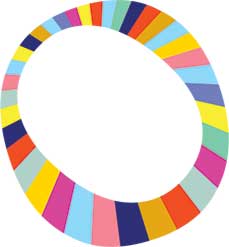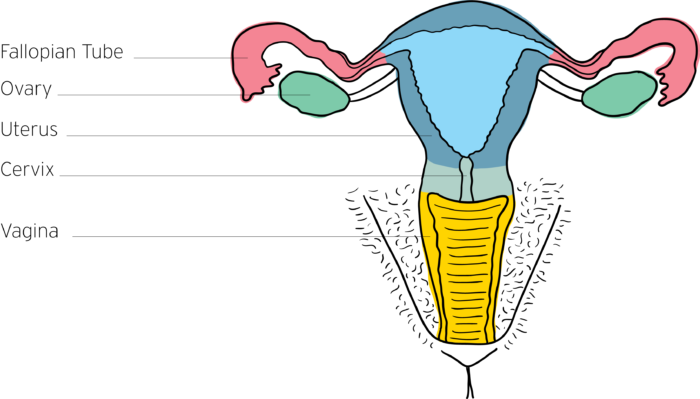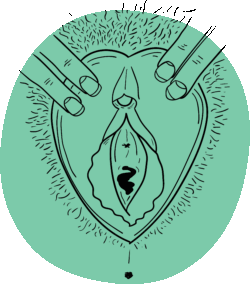 Vagina
Vagina
This part of the body is found inside, through the vaginal opening. Although it appears straight up in this image, the vagina tilts back toward the tailbone, and the uterus tilts forward.
The Vagina + Other parts inside the body
Vagina
The vagina is the part of the body that goes from the uterus to the outside of the body. The walls of the vagina sit closed, touching each other unless something like a tampon is inserted. On average, the vagina can be 3-5 inches long but can become longer if someone is feeling sexually excited.
The G-Spot (Grafenburg Spot)
Named after Dr. Grafenberg, it is an area on the vaginal wall closest to the internal portion of the clitoris. Pressure on this area can give the sensation of having to pee (urinate). Some people enjoy having it stimulated while others do not. The G-Spot is associated with “female ejaculation” (squirting), but not everyone experiences this.
Skene’s Glands
The tiny glands inside the urethral opening where ejaculate (sometimes called “female ejaculation” or squirting) comes from.
Cervix
The part of the body between the uterus and the vagina. It has a small opening called the cervical canal where period fluid can exit the uterus or sperm can enter.
Uterus
The organ where periods come from. The uterus is made of muscle that can experience cramps during a period. This is where a fertilized egg could attach and grow during pregnancy.
Fallopian Tubes
The two tubes that move eggs from the ovaries to the uterus. The fallopian tubes are not attached to the ovaries but their ends, called fimbriae, sweep the eggs into the tubes when they come out of the ovaries.
Ovaries
Two glands, each about the size of an almond. This is where eggs are stored. The hormones estrogen, progesterone and testosterone are also made here.
Fluids that leave the vagina
Vaginal Discharge
A person may notice a sticky fluid in their underwear that can be clear, white, or yellow. The body makes this fluid every day to keep the vagina healthy. The amount of fluid and what it looks like will change throughout the month, and it can be different from person to person, too. Sometimes this fluid dries on underwear, but it will wash out.
Period Fluid/Menstruation
A period is the lining of the uterus leaving the body. About 4-6 tablespoons of blood and fluid may leave the uterus during a period.
Starting to have a period is a sign that a person’s body can get pregnant. People may get their first period sometime between ages 8-16, but this is different for everyone. Some people experience their first period at an earlier or later age, too.
Periods usually come every 21-40 days apart and can last between 2-10 days. People can keep track of their menstrual cycles on a calendar or a phone app. This will help them know when to expect their next period. Mark the day on the calendar when a period starts and count how many days go by until the next one begins.
A person might skip their period sometimes. This is very normal for someone under the age of 25. Some other reasons a period may not come include being pregnant, experiencing stress, being sick, having a very low body weight, or because of taking certain medications.
 Vulva
Vulva
This part of the body is called the vulva. The vulva is underneath the body, and between the legs, so it can be hard for someone to see their own vulva without a mirror.
No two bodies look the same, so it’s perfectly normal if this isn’t exactly what someone’s vulva looks like. Vulvas can be of many shapes, sizes and complexions (colours). Some people may have had parts of the vulva removed through genital cutting (sometimes called female circumcision), while others may have had other types of surgeries involving their genitals for a variety of medical reasons. Childbirth can also change the appearance of the vulva for some people.
There are so many reasons why bodies look different, which is why we should try not to compare our bodies to others.
Parts of the Vulva
Vulva
The parts on the outside of the body are called the vulva, but the different parts of the vulva have their own names. We’ll explain these different parts below.
Mons Pubis
The fleshy part that covers the outside of the pubic bone. During puberty, hair grows here. This is the part someone can see if they are looking down.
Pubic Hair
The hair that grows on and around the genitals during and after puberty. Pubic hair is different from person to person; it can be straight or curly, a lot or a little, and black, brown, blonde, white, red, auburn or grey. Some people shave their pubic hair, and some don’t.
Labia Majora
The outer lips or fleshy folds that a person can see on the outside of the body. Their job is to protect the inner parts, and they are usually covered with pubic hair after puberty. Labia come in different sizes, shapes and colours.
Labia Minora
The inner lips that sit between the labia majora (outer lips). To see them, someone might want to use their fingers to move the outer lips aside. Inner lips don’t have pubic hair. They are thinner than the outside labia and more sensitive to touch. They also come in different sizes, shapes and colours. During sexual pleasure, blood flows to the inner lips, and they can look darker and bigger. The inner lips may stick out or stay tucked inside the outer labia.
Clitoris
The sensitive organ made up of nerves, located above the urethral opening. Most of the clitoris is inside the body where it can’t be seen. The tip of the clitoris is covered by the clitoral hood. When someone has sexual feelings, the clitoris fills with blood and becomes larger. Touching the clitoris can feel good for some people.
Urethral Opening
The non-stretchy opening where pee (urine) leaves the body. Some people may also notice ejaculate leaving this opening during orgasm sometimes (“squirting”), though not every person releases this type of fluid. It is normal either way.
Vaginal Opening
The opening on the outside of the body that leads to the vagina. This is where menstrual (period) fluid leaves the body. If a tampon is used during a period, this is where it goes into the vagina.
Hymen
The stretchy layer of skin inside the vagina near the vaginal opening. All hymens are different, and some people have them while others do not. Often the hymen will stretch and move to the side of the vaginal wall while a person is growing up. If inserting a tampon or a finger into the vagina causes pain or discomfort, this could be because of the hymen. A person can gently insert a finger into their vagina to stretch the hymen so a tampon can be inserted.
Perineum
The area between the vaginal opening and the anus. Some people find this area pleasurable and sensitive to touch.
Anus
The opening where poo (feces) leaves the body. Some people find it sensitive and pleasurable to touch.


 Vagina
Vagina Vulva
Vulva